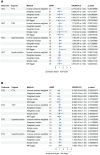Protective effect of higher free thyroxine levels within the reference range on biliary tract cancer risk: a multivariable mendelian randomization and mediation analysis
- PMID: 38686204
- PMCID: PMC11056546
- DOI: 10.3389/fendo.2024.1379607
Protective effect of higher free thyroxine levels within the reference range on biliary tract cancer risk: a multivariable mendelian randomization and mediation analysis
Abstract
Background: Hepatobiliary cancer (HBC), including hepatocellular carcinoma (HCC) and biliary tract cancer (BTC), is currently one of the malignant tumors that mainly cause human death. Many HBCs are diagnosed in the late stage, which increases the disease burden, indicating that effective prevention strategies and identification of risk factors are urgent. Many studies have reported the role of thyroid hormones on HBC. Our research aims to assess the causal effects and investigate the mediation effects between thyroid function and HBC.
Methods: Utilizing the Mendelian randomization (MR) approach, the study employs single nucleotide polymorphisms (SNPs) as instrumental variables (IVs) to explore causal links between thyroid function [free thyroxine (FT4), thyroid stimulating hormone (TSH), hyperthyroidism and hypothyroidism] and HBC. Data were sourced from the ThyroidOmic consortium and FinnGen consortium. The analysis included univariable and multivariable MR analysis, followed by mediation analysis.
Results: The study found a significant causal association between high FT4 levels and the reduced risk of BTC, but not HCC. However, TSH, hyperthyroidism and hypothyroidism had no causal associations with the risk of HBC. Notably, we also demonstrated that only higher FT4 levels with the reference range (FT4-RR) could reduce the risk of BTC because this protective effect no longer existed under the conditions of hyperthyroidism or hypothyroidism. Finally, we found that the protective effect of FT4-RR on BTC was mediated partially by decreasing the risk of metabolic syndrome (MetS) and reducing the waist circumference (WC).
Conclusion: The findings suggest that higher FT4-RR may have a protective effect against BTC, which is partially mediated by decreased risk of MetS and a reduction in WC. This study highlights the potential role of FT4 in the pathogenesis of BTC and underscores that MetS and WC may play mediation effects as two mediators in this process.
Keywords: Mendelian randomization; free thyroxine; hepatobiliary cancer; metabolic syndrome; thyroid function; waist circumference.
Copyright © 2024 Chen, Dong, Qu, Ma and Lu.
Conflict of interest statement
The authors declare that the research was conducted in the absence of any commercial or financial relationships that could be construed as a potential conflict of interest.
Figures



Similar articles
-
Causal relationship between thyroid dysfunction and gastric cancer: a two-sample Mendelian randomization study.Front Endocrinol (Lausanne). 2024 Apr 26;15:1335149. doi: 10.3389/fendo.2024.1335149. eCollection 2024. Front Endocrinol (Lausanne). 2024. PMID: 38737547 Free PMC article.
-
Assessment of the Relationship Between Genetic Determinants of Thyroid Function and Atrial Fibrillation: A Mendelian Randomization Study.JAMA Cardiol. 2019 Feb 1;4(2):144-152. doi: 10.1001/jamacardio.2018.4635. JAMA Cardiol. 2019. PMID: 30673084 Free PMC article.
-
Effects of Thyroid Function on Hemostasis, Coagulation, and Fibrinolysis: A Mendelian Randomization Study.Thyroid. 2021 Sep;31(9):1305-1315. doi: 10.1089/thy.2021.0055. Epub 2021 Aug 5. Thyroid. 2021. PMID: 34210154 Free PMC article.
-
The causal relationship between thyroid function, autoimune thyroid dysfunction and lung cancer: a mendelian randomization study.BMC Pulm Med. 2023 Sep 11;23(1):338. doi: 10.1186/s12890-023-02588-0. BMC Pulm Med. 2023. PMID: 37697335 Free PMC article.
-
Causal role of thyroid function in functional outcome after ischemic stroke: A Mendelian randomization study.J Stroke Cerebrovasc Dis. 2024 Dec;33(12):108019. doi: 10.1016/j.jstrokecerebrovasdis.2024.108019. Epub 2024 Sep 18. J Stroke Cerebrovasc Dis. 2024. PMID: 39303866
Cited by
-
Causal Effects and Immune Cell Mediators of Prescription Analgesic Use and Risk of Liver Cancer and Precancerosis in European Population: A Mendelian Randomization Study.Biomedicines. 2024 Jul 11;12(7):1537. doi: 10.3390/biomedicines12071537. Biomedicines. 2024. PMID: 39062110 Free PMC article.
References
Publication types
MeSH terms
Substances
LinkOut - more resources
Full Text Sources

